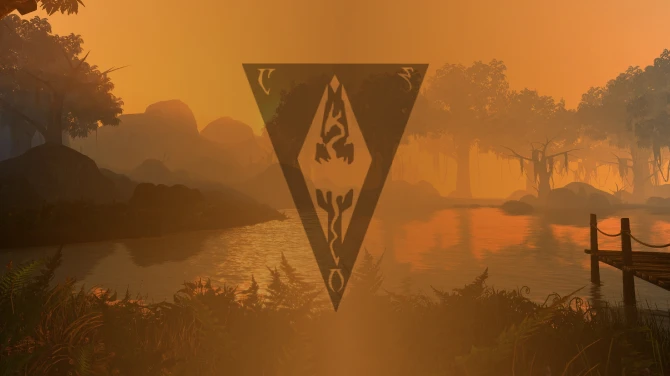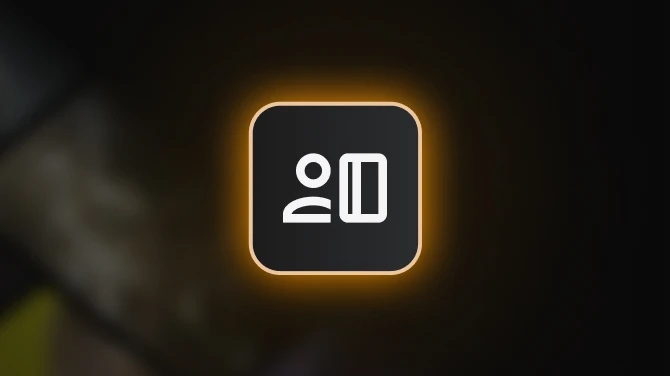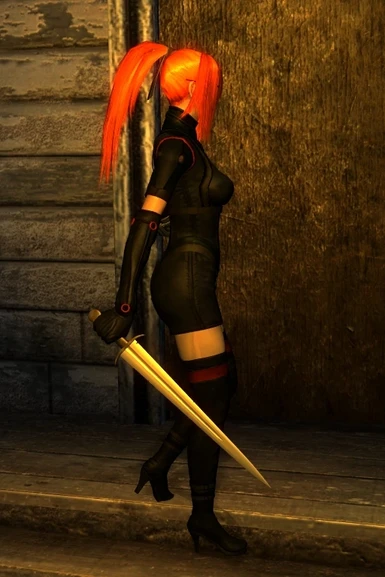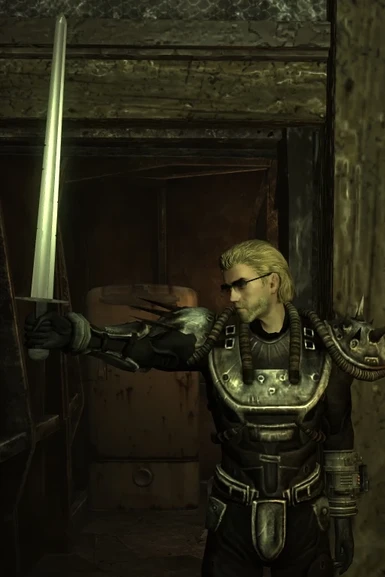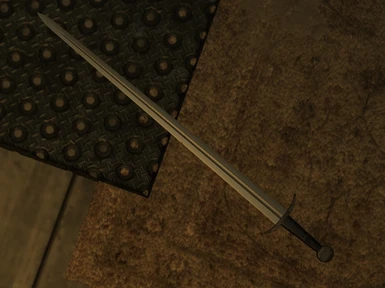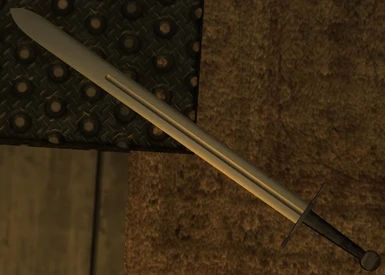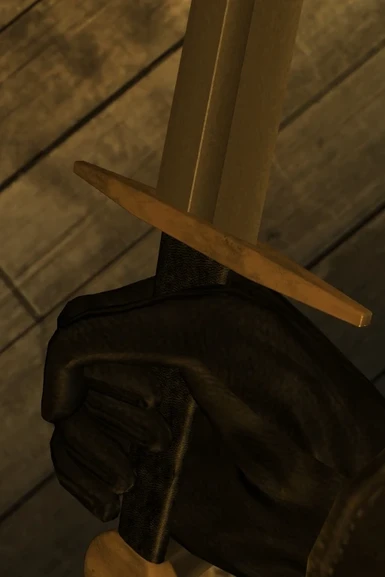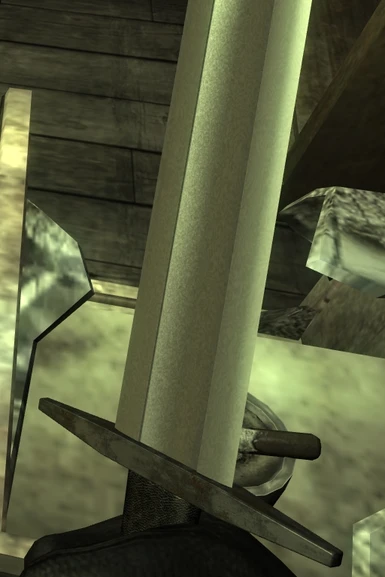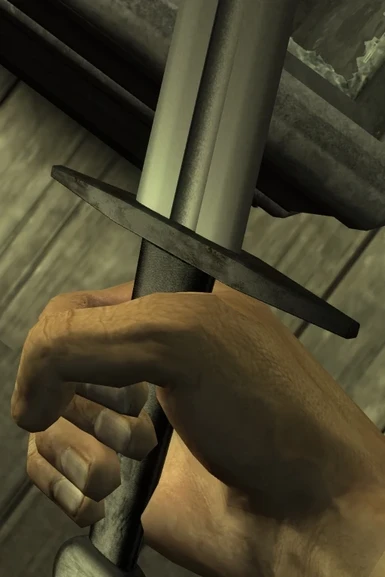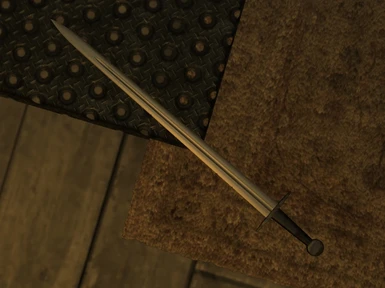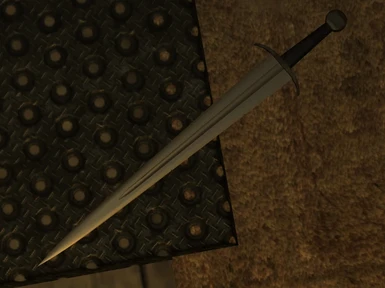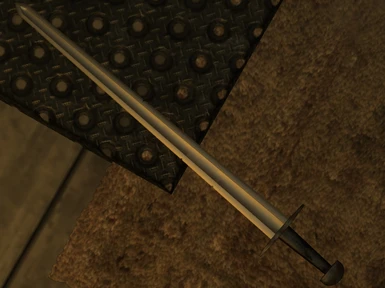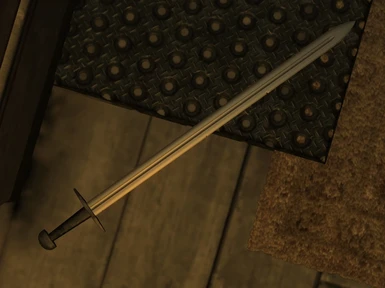WHAT IT DOES
It adds a couple of authentic broadswords from the European High Middle Ages, because if I'm going to play a Paladin Of Steel, I want a weapon fit for a real Knight Palatine ;)
The weapons ARE powerful, but need 100 skill. I.e., the damage and accuracy start lower, but increase as your skill increases, all the way to 100. I.e., they more or less grow with you as you level up and advance your melee skill.
All stated types are the Oakeshott sword types, in as much as I can judge what type a sword is. Bear in mind though that swords were not made identical, and there was no such thing as buying a "Type X" sword at the time. There were thousands of smiths across a whole continent and across several centuries, and pretty much infinite variation in the swords they produced. So if my Type X is half an inch shorter than your Type X, well, please bear with me.
The blades are made of pattern-welded steel, a.k.a., folded steel, hence the pattern. A few were even made of imported Damascus steel, but most of the good swords were just folded steel. It was actually quite popular back then. E.g., the mention of a "wave sword" in Beowulf is thought to refer to the wavy pattern of folded steel.
The hilts are rusty and stained and dull, but the blades are polished and oiled. No warrior worth his salt would go into battle with a rusty blade. And those who did, tended to not live long and prosper, if you catch my drift. They do have their fair share of nicks in the edge though, because they're weapons used in battle.
The swords are:
1. Type X: Very similar to the earlier Viking swords. It is very broad, with a wide and shallow fuller. The fuller is in fact about half the width of the blade, and going almost all the way to the tip. It has a rather mediocre tip, and historical examples even had rounded tips, as this was primarily a cutting sword, not a piercing sword.
This particular example has a blade about 30 inches long and a whole 2.4 inches wide at the base, but tapers to about half that before starting to converge into a tip. The combination of taper and distal taper makes for a centre of gravity quite close to the hilt, and a sword which actually allows more swift slashes than it looks.
The hilt is a rather typical one, including a mushroom or "tea-cozy" pommel, albeit with a longer grip than historical ones, to acount for the Fallout animations and the fact that the hand moves back on the hilt in third person. I am making game swords, after all, not museum pieces, so they have to fit the game animations.
2. Type XI: It is more slender, with parallel edges, and a better tip. Ok, not MUCH better, but it's starting to show that fighting styles were starting to use thrusts too. The fuller still goes almost all the way to the tip, but is much narrower than Type X fullers. On this particular example, it's only about a quarter of the blade's width.
This particular example has a blade about 36 inches long (these were cavalry swords) and 1.8 inches wide for most of its length. The hilt is the same as for the Type X above, and with the same caveat.
3. Type XII: Another tapering sword, although not as acutely as the later Type XIV, and with a very good piercing tip. With the increase in armour and reinforcements, it was obviously becoming necessary to use more thrusts, yet still be able to deliver a hefty slice against maille. This is probably the most archetypal "knightly sword", and of a size that made it a good weapon both on horse and on foot.
This particular example has a blade about 32.5 inches long. It starts 2.1 inch at the hilt, but it tapers visibly from there. The fuller is long for this type, but not ahistorical.
There are historical examples of such swords with a Type XII outline and an almost Type XI or even Xa fuller.
The hilt has a straight "spike" cross and disc pommel, a fairly usual pommel for this type and not an unusual cross either.
4. Type XIII: The Type XIII is not a continuation of Type XII, but a parallel evolution, with a different philosophy in mind. While the Type XII was evolving in the direction of becoming better at piercing, the Type XIII essentially allowed harder hits with the edge, by having a hilt long enough to allow using a second hand on the pommel if needed. I.e., these are the first hand-and-half swords. (Subtype XIIIa even allowed normal two-handed use, becoming some of the first "great swords".) As a consequence of this focus on cutting not thrusting, Type XIII swords continued to have tips that were mediocre at best and often even rounded. The edges run parallel for most of the sword's length, which combined with the fairly wide blade, would allow it to pack a lot of momentum when swung with both hands.
This is another blade considered nowadays an archetypal "knightly sword", although, judging by the relatively few specimens left, it seemed to be less popular than the Type XII swords at the time.
This particular example has a 2.25 wide blade for most of its length, and about 32.5 inch long, and with a fairly typical fuller length for this type. The hilt has a fairly typical grip for this type, a little over 6 inches long, a disc pommel, and style 2 cross (a variant of the straight knightly cross where the quillons narrow down and then flare in width again.)
5. Type XIV: Flat blade that starts broad, but tapers strongly right from the hilt, to a very sharp tip. This is truly a cut and thrust sword. Some have shorter and somewhat broad fullers, some have twin narrow fullers that are even shorter. This particular example is the former type.
This particular example has a blade about 27-2/3 inches long. It starts about 3 inch wide at the base, but it narrows down pretty quickly. The single fuller is somewhat on the long side for this type, but still in the very historical range.
The hilt is a pretty typical one for this type, with a curved cross and a disc pommel. This time it's not too long, as for this type there are historical hilts about this long.
6. Type XVIIId: this is kinda the mean grandson of the Type XIV. It has a strongly tapering blade, with a nasty tip, and a thicker and stiffer diamond-section blade, although some still have very slightly convex faces. Unlike the other Type XVIII variants, the XVIIId has a long fuller, going almost all the length of the blade.
This particular example has a blade about 35.5 inches long. It starts 2.1 inch at the hilt, but it tapers visibly from there. The fuller is a typical one for this type, as described above. The blade is slightly convex, but still mostly a diamond section blade.
These blades have been mounted on almost any hilt type, though curved or twisted crosses seem more common than other types, so I gave it a curved cross and a disc pommel.
You may recognize this blade as a less blinged-up version of the ceremonial sword from The Tudors. (Though you can get shiny yellow fittings like that one via the optional download.) Which is another reason why I gave it that particular hilt. Although no such sword of Henry VIII is actually in any collection or museum, the sword is nevertheless a historical blade type in use in that period.
NOTE: According to some modern classifications, "Arming Sword" refers strictly to the knightly swords of the High Middle Ages (Types XI, XII, and XIII), and sometimes the term is used to mean all of the Group 1 swords (Type X to Type XIV) with lenticular blades and whose main goal is to defeat chain, not plate. However, historically, after the rise and spread of two-handed "longswords" in the 14'th century, the term "arming sword" was commonly used to mean any one-handed sword worn hanging from the belt, as opposed to the two-hander "longswords" which were hanging from the saddle for knights. I'm using this latter meaning for the name of the mod.
OPTIONAL TEXTURES
An optional download changes the pommels and crosses to shiny (but still dirty and tarnished) yellow metal. Brass hilts were favoured in the Renaissance in some places like Scotland because they're much more corrosion resistant than steel, and it rained lots. From the middle ages, we don't actually have brass hits, but we do have examples of "fire gilt" gold-plated hilts made for kings and nobles. There also is evidence in contemporary art of yellow metal on pommels and crosses, though we don't know if it was supposed to be brass, bronze or gold-plated steel. Take your pick.
But if you don't want brass/bronze/gold on your hilt, you can just ignore it.
If you do want it, you'll need to install the main file first, then unpack the optional file in your Data directory and confirm that you want to overwrite the existing texture files.
RETEXTURING AND MODDING
As most of my mods, it's designed for ease of retexturing, so the textures are separate pieces, and the mapping such that you can just swap in some other material. Essentially, if you have any other photo of a metal surface, as long as it's a power of 2 in pixels for width and height (256, 512, 1024, 2048 or 4096), you can just swap it in and have a blade in the metal of your choice. Ditto for the cross. So if you want a rusty blade or a brass cross or whatever, you can help yourself.
The mesh pieces are separate too, somewhat like in Neverwinter Nights 2, so if you're not affraid to copy nodes around in NifSkope, you can mix and match. Think of them as Lego swords, basically ;)
HOW TO GET IT
Method 1: If you want to EARN your powerful swords, there is a metal box with all the swords in the back of the Deathclaw-infested quary, between the big crane and one of those small pools of water. If as a melee char you could beat up the Deathclaws or, I guess, sneak past all of them, you're already powerful enough that these won't even start to unbalance you.
Method 2: I gave all of them to Chet in Goodsprings. You can buy your blades there whenever you have the money.
HOW TO INSTALL IT
Extract the archive, with directories, in your "fallout new vegas\Data" folder. Select it in the list of plugin files in the launcher.
HOW TO UNINSTALL IT
Delete the .esp file from your Data directory.
Delete the MArmingSword directory in both the Meshes and Textures directories.
CONFLICTS
It shouldn't conflict with anything.
LICENSE
I release it in the public domain. You can do anything you wish with it. I would, of course, appreciate it if you give credit, but if not, so be it, I can live with that too.
VERSION HISTORY
1.02:
Fixed the description of the mod in the .esp (was still the one for WOTS)
Changed the icons to something more apropriate
Added a second crate at the Deathclaws, in case someone killed Chet or something
Added a Type XIII sword
Added a Type XVIIId sword
1.01:
Reworked the Type XIV blade, the tip is now less needle-like
Made the grips a little less tapered, for aesthetic reasons
Made the leather on the grip darker, so it doesn't look almost identical in colour to the pommel
Gave the Type XIV a bigger disc as a pommel
Lengthened the Type XI blade to a more average 36 inches. These were cavalry swords, unlike the Type XIa.
Fixed the wonky shading at the top of the fuller on the Type XI while I was at it.
Added the Type XII.
1.0:
First NV Release
It adds a couple of authentic broadswords from the European High Middle Ages, because if I'm going to play a Paladin Of Steel, I want a weapon fit for a real Knight Palatine ;)
The weapons ARE powerful, but need 100 skill. I.e., the damage and accuracy start lower, but increase as your skill increases, all the way to 100. I.e., they more or less grow with you as you level up and advance your melee skill.
All stated types are the Oakeshott sword types, in as much as I can judge what type a sword is. Bear in mind though that swords were not made identical, and there was no such thing as buying a "Type X" sword at the time. There were thousands of smiths across a whole continent and across several centuries, and pretty much infinite variation in the swords they produced. So if my Type X is half an inch shorter than your Type X, well, please bear with me.
The blades are made of pattern-welded steel, a.k.a., folded steel, hence the pattern. A few were even made of imported Damascus steel, but most of the good swords were just folded steel. It was actually quite popular back then. E.g., the mention of a "wave sword" in Beowulf is thought to refer to the wavy pattern of folded steel.
The hilts are rusty and stained and dull, but the blades are polished and oiled. No warrior worth his salt would go into battle with a rusty blade. And those who did, tended to not live long and prosper, if you catch my drift. They do have their fair share of nicks in the edge though, because they're weapons used in battle.
The swords are:
1. Type X: Very similar to the earlier Viking swords. It is very broad, with a wide and shallow fuller. The fuller is in fact about half the width of the blade, and going almost all the way to the tip. It has a rather mediocre tip, and historical examples even had rounded tips, as this was primarily a cutting sword, not a piercing sword.
This particular example has a blade about 30 inches long and a whole 2.4 inches wide at the base, but tapers to about half that before starting to converge into a tip. The combination of taper and distal taper makes for a centre of gravity quite close to the hilt, and a sword which actually allows more swift slashes than it looks.
The hilt is a rather typical one, including a mushroom or "tea-cozy" pommel, albeit with a longer grip than historical ones, to acount for the Fallout animations and the fact that the hand moves back on the hilt in third person. I am making game swords, after all, not museum pieces, so they have to fit the game animations.
2. Type XI: It is more slender, with parallel edges, and a better tip. Ok, not MUCH better, but it's starting to show that fighting styles were starting to use thrusts too. The fuller still goes almost all the way to the tip, but is much narrower than Type X fullers. On this particular example, it's only about a quarter of the blade's width.
This particular example has a blade about 36 inches long (these were cavalry swords) and 1.8 inches wide for most of its length. The hilt is the same as for the Type X above, and with the same caveat.
3. Type XII: Another tapering sword, although not as acutely as the later Type XIV, and with a very good piercing tip. With the increase in armour and reinforcements, it was obviously becoming necessary to use more thrusts, yet still be able to deliver a hefty slice against maille. This is probably the most archetypal "knightly sword", and of a size that made it a good weapon both on horse and on foot.
This particular example has a blade about 32.5 inches long. It starts 2.1 inch at the hilt, but it tapers visibly from there. The fuller is long for this type, but not ahistorical.
There are historical examples of such swords with a Type XII outline and an almost Type XI or even Xa fuller.
The hilt has a straight "spike" cross and disc pommel, a fairly usual pommel for this type and not an unusual cross either.
4. Type XIII: The Type XIII is not a continuation of Type XII, but a parallel evolution, with a different philosophy in mind. While the Type XII was evolving in the direction of becoming better at piercing, the Type XIII essentially allowed harder hits with the edge, by having a hilt long enough to allow using a second hand on the pommel if needed. I.e., these are the first hand-and-half swords. (Subtype XIIIa even allowed normal two-handed use, becoming some of the first "great swords".) As a consequence of this focus on cutting not thrusting, Type XIII swords continued to have tips that were mediocre at best and often even rounded. The edges run parallel for most of the sword's length, which combined with the fairly wide blade, would allow it to pack a lot of momentum when swung with both hands.
This is another blade considered nowadays an archetypal "knightly sword", although, judging by the relatively few specimens left, it seemed to be less popular than the Type XII swords at the time.
This particular example has a 2.25 wide blade for most of its length, and about 32.5 inch long, and with a fairly typical fuller length for this type. The hilt has a fairly typical grip for this type, a little over 6 inches long, a disc pommel, and style 2 cross (a variant of the straight knightly cross where the quillons narrow down and then flare in width again.)
5. Type XIV: Flat blade that starts broad, but tapers strongly right from the hilt, to a very sharp tip. This is truly a cut and thrust sword. Some have shorter and somewhat broad fullers, some have twin narrow fullers that are even shorter. This particular example is the former type.
This particular example has a blade about 27-2/3 inches long. It starts about 3 inch wide at the base, but it narrows down pretty quickly. The single fuller is somewhat on the long side for this type, but still in the very historical range.
The hilt is a pretty typical one for this type, with a curved cross and a disc pommel. This time it's not too long, as for this type there are historical hilts about this long.
6. Type XVIIId: this is kinda the mean grandson of the Type XIV. It has a strongly tapering blade, with a nasty tip, and a thicker and stiffer diamond-section blade, although some still have very slightly convex faces. Unlike the other Type XVIII variants, the XVIIId has a long fuller, going almost all the length of the blade.
This particular example has a blade about 35.5 inches long. It starts 2.1 inch at the hilt, but it tapers visibly from there. The fuller is a typical one for this type, as described above. The blade is slightly convex, but still mostly a diamond section blade.
These blades have been mounted on almost any hilt type, though curved or twisted crosses seem more common than other types, so I gave it a curved cross and a disc pommel.
You may recognize this blade as a less blinged-up version of the ceremonial sword from The Tudors. (Though you can get shiny yellow fittings like that one via the optional download.) Which is another reason why I gave it that particular hilt. Although no such sword of Henry VIII is actually in any collection or museum, the sword is nevertheless a historical blade type in use in that period.
NOTE: According to some modern classifications, "Arming Sword" refers strictly to the knightly swords of the High Middle Ages (Types XI, XII, and XIII), and sometimes the term is used to mean all of the Group 1 swords (Type X to Type XIV) with lenticular blades and whose main goal is to defeat chain, not plate. However, historically, after the rise and spread of two-handed "longswords" in the 14'th century, the term "arming sword" was commonly used to mean any one-handed sword worn hanging from the belt, as opposed to the two-hander "longswords" which were hanging from the saddle for knights. I'm using this latter meaning for the name of the mod.
OPTIONAL TEXTURES
An optional download changes the pommels and crosses to shiny (but still dirty and tarnished) yellow metal. Brass hilts were favoured in the Renaissance in some places like Scotland because they're much more corrosion resistant than steel, and it rained lots. From the middle ages, we don't actually have brass hits, but we do have examples of "fire gilt" gold-plated hilts made for kings and nobles. There also is evidence in contemporary art of yellow metal on pommels and crosses, though we don't know if it was supposed to be brass, bronze or gold-plated steel. Take your pick.
But if you don't want brass/bronze/gold on your hilt, you can just ignore it.
If you do want it, you'll need to install the main file first, then unpack the optional file in your Data directory and confirm that you want to overwrite the existing texture files.
RETEXTURING AND MODDING
As most of my mods, it's designed for ease of retexturing, so the textures are separate pieces, and the mapping such that you can just swap in some other material. Essentially, if you have any other photo of a metal surface, as long as it's a power of 2 in pixels for width and height (256, 512, 1024, 2048 or 4096), you can just swap it in and have a blade in the metal of your choice. Ditto for the cross. So if you want a rusty blade or a brass cross or whatever, you can help yourself.
The mesh pieces are separate too, somewhat like in Neverwinter Nights 2, so if you're not affraid to copy nodes around in NifSkope, you can mix and match. Think of them as Lego swords, basically ;)
HOW TO GET IT
Method 1: If you want to EARN your powerful swords, there is a metal box with all the swords in the back of the Deathclaw-infested quary, between the big crane and one of those small pools of water. If as a melee char you could beat up the Deathclaws or, I guess, sneak past all of them, you're already powerful enough that these won't even start to unbalance you.
Method 2: I gave all of them to Chet in Goodsprings. You can buy your blades there whenever you have the money.
HOW TO INSTALL IT
Extract the archive, with directories, in your "fallout new vegas\Data" folder. Select it in the list of plugin files in the launcher.
HOW TO UNINSTALL IT
Delete the .esp file from your Data directory.
Delete the MArmingSword directory in both the Meshes and Textures directories.
CONFLICTS
It shouldn't conflict with anything.
LICENSE
I release it in the public domain. You can do anything you wish with it. I would, of course, appreciate it if you give credit, but if not, so be it, I can live with that too.
VERSION HISTORY
1.02:
Fixed the description of the mod in the .esp (was still the one for WOTS)
Changed the icons to something more apropriate
Added a second crate at the Deathclaws, in case someone killed Chet or something
Added a Type XIII sword
Added a Type XVIIId sword
1.01:
Reworked the Type XIV blade, the tip is now less needle-like
Made the grips a little less tapered, for aesthetic reasons
Made the leather on the grip darker, so it doesn't look almost identical in colour to the pommel
Gave the Type XIV a bigger disc as a pommel
Lengthened the Type XI blade to a more average 36 inches. These were cavalry swords, unlike the Type XIa.
Fixed the wonky shading at the top of the fuller on the Type XI while I was at it.
Added the Type XII.
1.0:
First NV Release






